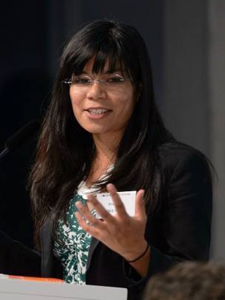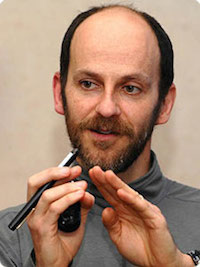Perspectives from Bowdoin Professors on the New Climate Deal
By Rebecca GoldfineWe asked professors from different disciplines to weigh in on the new agreement among 195 nations to reduce global emissions in an attempt to save our planet from the worst effects of climate change. Three faculty from the government and legal studies department offered their thoughts — Laura Henry, Allen Springer and Divya Gupta — as well as physicist Mark Battle, economist Erik Nelson, and Shu-chin Tsui, an expert in China.
Laura Henry, government and legal studies
 Laura Henry, the John F. and Dorothy H. Magee Associate Professor in Government And Legal Studies, researches social movements, particularly environmental movements, and the politics of Russia and the post-Soviet republics.
Laura Henry, the John F. and Dorothy H. Magee Associate Professor in Government And Legal Studies, researches social movements, particularly environmental movements, and the politics of Russia and the post-Soviet republics.
Russia was on the world stage at the Paris climate talks – for once not as a spoiler of global rules (redrawing borders in Ukraine or acting unilaterally in Syria), but instead as a constructive force supporting a global agreement. President Vladimir Putin opened Russia’s participation in the conference with a speech acknowledging climate change as a serious problem and pledging that Russia would be part of the solution. He also took the opportunity to meet Obama and Merkel on the sidelines of the talks, meetings that symbolized the necessity of Russia’s cooperation in resolving issues of climate and beyond. Putin’s position on climate change represents a notable shift in his rhetoric from a decade ago when he remarked that following global warming Russians would need to “spend less on fur coats and the grain harvest would increase.”
Russia has played an ambiguous role in UNFCCC climate negotiations for almost two decades. Russia’s ratification of the Kyoto protocol allowed the agreement to come into force once the U.S. declined to participate. However, the country’s cooperation on global climate negotiations has been based on two important factors. First, Russia’s post-Soviet industrial collapse provided space for the country to make significant commitments to greenhouse gas reductions without needing to take painful action to lower emissions in practice. Russia’s greenhouse gas emissions peaked in 1990 before plummeting in the 1990s. Emissions remained almost 50 percent below 1990 levels in 2012. As a result, Russia’s commitment to keep emissions at 25-30 percent below 1990 levels by 2030 actually allows the state to increase greenhouse gas emissions during the next 15 years, possibly by as much as 40 percent. Second, Russia has insisted that its forested territory be counted as a carbon sink and weighed in its favor when calculating total annual emissions. This accounting creates even greater potential for emissions increases in other sectors, such as the oil and gas industry which accounts for a significant proportion of Russia’s current carbon emissions.
Russia does appear determined to increase its energy efficiency and the competitiveness of its economy in the coming years, even as its future growth rests solidly on global demand for hydrocarbons in the short term. Under the current agreement, Russia has the freedom to significantly decrease or increase emissions by pursuing difference energy policies. Whether the Putin regime will prioritize policies that reduce emissions remains in doubt.
Erik Nelson, economics

Assistant Professor of Economics Erik Nelson
Assistant Professor of Economics Erik Nelson studies the economics of conservation biology, ecosystem services and climate change.
I have never believed that countries around the world would be willing to drastically cut their fossil fuel use in just one generation in order to contribute to serious climate change mitigate. Right now fossil fuels are just too portable, storable, and cost-effective for an ever expanding world to credibly consider a substantial fossil fuel diet. Feeding a world expected to expand to 9.6 billion people by 2050 will require portable, storable, and cheap energy. And right now only fossil fuels have all three of these characteristics. Therefore, I am pleased to see that the Paris agreement has focused on what I believe is the only long-term and permanent solution to the climate change crisis: eventually making carbon-light and carbon-free energy just as portable, storable, and cheap as fossil fuels. (One caveat: biofuels cannot be part of the long-term solution; the cost they impose on the environment is just too high to warrant widespread use.) This will require a serious global investment in alternative energy research R&D and an end to all fossil fuel subsidies around the world. In addition, a global carbon tax is a must to help close the cost gap between fossil-based and alternative energy sources. However, we need to be judicious in our use of this tax as we segue to an alternative energy future. Economic growth over the next several decades in many African, Central America, and Southeast Asian countries will depend on the supply of relatively cheap fossil fuel.
Divya Gupta, government and environmental studies
 Visiting Assistant Professor of Government and Environmental Studies Divya Gupta’s research encompasses environment and development discourses, especially in connection to community-based natural resource management.
Visiting Assistant Professor of Government and Environmental Studies Divya Gupta’s research encompasses environment and development discourses, especially in connection to community-based natural resource management.
Agreement at the COP21 is seen as a huge success; never in the history of COP meetings have the nations agreed so unanimously. While this global consensus is an achievement, it is important to know that the success of this meeting does not translate to an immediate end to global collective action problems. The agreement is only a starting point, but the action will come mostly from outside of the agreement – from national governments, political parties, interest groups, sub-national jurisdictions, environmental organizations, and billions of individuals looking for better lives.
The INDC (Intended Nationally Determined Contribution) reports, submitted by 186 countries prior to the conference, were an important part of COP21. In the INDC reports, the respective countries pledged climate goals they plan to achieve by 2030. As per the agreement, every five years these countries need to communicate progress they have made in achieving those goals. The initial goal of 2 degrees has been reduced to 1.5 by the COP agreement. This push to prevent temperature rise beyond 1.5 degrees is seen as a potential pressure on the developing countries, especially fast-developing and coal-dependent economies like India and China. While China clearly established its intention to make serious efforts towards reducing GHG emissions, by signing a landmark agreement with the US in November 2014, India remains the biggest challenge in global climate negotiations.
Approximately 55% of India’s energy supply is dependent on coal; looking at the coal consumption trajectory, it is predicted that the country’s primary supply of coal will increase by at least 3-4 times in the next five years. At COP 21, India’s coal plans came under repeated attack from developed countries and western media, which was expected. However, India played safe politics by clearly articulating its genuine commitment to environment protection, and also clarifying its demand for increased “carbon space” by insisting on the country’s need for continued growth. In the same vein, the country also requested for monetary support from developed countries by invoking the differentiation principle (as per the differentiation principle, developed countries are to take greater responsibility for the GHG emission they caused from 1850s-1980s). Needless to say, the country was able to clearly articulate its objective to balance environment protection without much compromising its economic growth. In its INDC, India pledged to reduce emissions by 33-35% by 2030 in comparison to its 2005 levels. It intends to do that by increasing the share of non-fossil fuel based power generation capacity to 40% and by creating additional carbon sink through increased forest and tree cover. If India fails to meet its goal, the global leaders can use that to arm-twist the country on the grounds of not pursuing a low-emission pathway.
As in India, the goals established in the INDC reports submitted by other countries are transparent, and countries will be held accountable if they fail to meet their emission goals. However, as simple as this might sound, meeting the emission reduction goals would require each country to overcome their respective political and economic barriers. So whether it is US, China, or India, the stakes are high in every country, and so are the catastrophic disasters and horrendous consequences for human welfare; therefore, there is no alternative but to be on the path of cleaner energy and its efficient use.
Allen Springer, government and legal studies
 Professor of Government Allen Springer specializes in international law and organization, international environmental policy, Canada-U.S. relations, and American foreign policy.
Professor of Government Allen Springer specializes in international law and organization, international environmental policy, Canada-U.S. relations, and American foreign policy.
The Paris agreement has been called historic. Whether it really deserves that label remains to be seen. However, what was negotiated at Paris is certainly important in several respects. First, there is the very fact that an agreement was drafted that 195 countries would accept, or at least not reject. If the negotiations had reached an impasse, it is difficult to imagine what the next steps internationally could have been. Second, the agreement recognizes practical reality and breaks away from the Kyoto Protocol approach whose mandatory targets and timetables were simply not negotiable given the political reality faced in the U.S. and elsewhere. Kyoto’s top-down approach was built on a model that appears to have worked effectively in controlling stratospheric ozone depletion but simply did not translate well into dealing with the more complex challenges posed by climate change. Third, by including all states among those responsible for assuming limitations on greenhouse gas emissions at some point, the Paris conference took a key step, given the growing role of China and India and other major developing countries as greenhouse gas emitters.
For the future, the success of the agreement depends less on the enforceability of existing pledges and more on an ongoing process of review and what its drafters hope will be the willingness of governments to accelerate dramatically their voluntary timetables for reducing greenhouse gases emissions. While technological breakthroughs may help, progress will depend heavily on public pressure to keep the issue of climate change high on crowded international agendas.
Disappointing to many was the fact that the text of the Paris Agreement itself does not commit developed countries to provide $100 billion in funds to promote mitigation and adaptation efforts in developing countries, but only includes it as a “decision” of the Conference to be implemented by 2025. Making a clearer commitment to provide these funds will likely be crucial to getting developing states to accelerate their own carbon dioxide reduction schedules. However, forcing the issue now would have put developed countries, particularly the United States, in a position where domestic opposition could have undercut the momentum the Agreement’s supporters hope to generate.
Shu-chin Tsui, Asian studies

Professor of Asian Studies and Cinema Studies Shu-chin Tsui is an expert in culture studies, cinema studies and Chinese literature and art.
What is at stake for China in agreeing to cut emissions and accommodate an outside monitoring system for emissions? China has no choice but to agree with other nations and accommodate an international monitoring system for emissions. China’s participation in the Paris climate change summit and acceptance of the final agreement puts China on the record; its international reputation is at stake. Moreover, domestic environmental conditions — the horrific smog in Beijing and elsewhere — have made air pollution and public health a problem that cannot be evaded. Although particulate matter and CO2 emissions are distinct problems, the link between industry, air pollution, and wellbeing is becoming fixed in public awareness.
Should China join the U.S and other nations in helping to pay for poorer nations to cut emissions? Yes, definitely, and China is able to, as President Xi Jinping has recently pledged $60 billion to assist industrial and economic development in Africa. But whether the investment will be applied to climate change prevention or other environmental projects depends on China’s political and economic interest in Africa. Poorer countries without much of an industrial base have an opportunity, with outside help, to move directly to renewables.
What are the environmental, political and/or economic challenges China faces in trying to cap greenhouse gas emissions?The dilemma between economic development and environmental protection has been well recognized. Challenges include also the possibility that policies made by the central government will be ignored by local authorities or circumvented through corruption, that authoritarian attempts to manipulate market practices will go awry, and that the regulatory capacity of the Chinese system is weak. China is not run by the rule of law, thereby the vested interests in the fossil fuel industry and ideologues in the GDP have the power to undermine the whole enterprise of reducing CO2 output. A balance has to be found, where economic growth and environmental protection should not be antagonistic but incorporative adjustment.
Mark Battle, physics

How are delegates at the Paris climate talks approaching the science of climate change, and how is this attitude different than the last major international climate conference? And are the pledges made by nations adequate to curtail dangerous climate change? If not, will this conference have been a failure in your eyes, even if a treaty is signed?
From a scientific perspective, it was clear a priori that if an agreement were to come out of Paris, there was absolutely no way it would limit global warming to 2°C. However, it was also clear that there was a broadly held desire to create some kind of positive path forward. Choices were explicitly made to avoid a repeat of the Copenhagen fiasco of 2009.
Our scientific understanding of climate change has evolved since 2009, but nothing has fundamentally changed. We recognize that some elements of the climate system are more sensitive to warming than we thought and others less so. Overall, we have reduced the (already modest) uncertainty in our predictions of warming for a given emission of CO2. Arguably, one of the most significant advances has been to recast the problem in terms of how much fossil fuel we must leave unburned. This makes the urgency of the problem particularly apparent.
Now we have an agreement in hand. It won’t limit warming to 2°C, let alone the 1.5°C that many low-lying nations hoped for. Emissions reductions are just pledges, and there is no enforcement mechanism. Nonetheless, for the first time in years I’m cautiously optimistic. Getting to the 2°C target will be very difficult, but it’s possible only if humanity acknowledges the gravity of the problem and shows a willingness engage with it. The Paris agreement does this.



